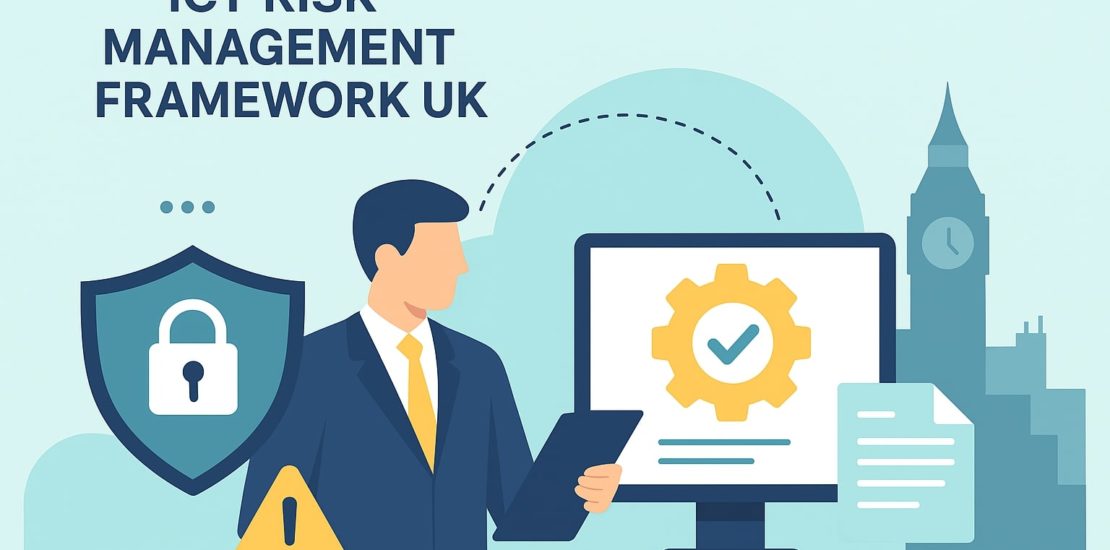How to Comply with the ICT Risk Management Framework in the UK
- October 7, 2025
- Posted by: Gradeon
- Category: Consulting

Technology drives every modern business, but it also introduces constant risks. A single cyberattack, software failure, or network outage can bring operations to a halt. The ICT Risk Management Framework was created to help UK organisations identify and manage these technology-based threats before they become disasters.
For regulated sectors — especially finance, insurance, and IT services — compliance is more than a box to tick. It’s the foundation for operational resilience and customer trust.
What the ICT Risk Management Framework Means
The framework is part of the UK’s broader regulatory effort under the Digital Operational Resilience Act (DORA) and FCA guidance. Its aim is simple: make sure organisations can withstand and recover from ICT disruptions.
It requires leaders to treat ICT risks as business risks — integrated into governance, strategy, and daily decision-making. When applied correctly, it transforms technology from a weak point into a competitive strength.
Why ICT Risk Management Matters
ICT failures don’t just stop systems; they stop sales, client relationships, and reputation. A data breach can lead to penalties, while downtime can push customers toward competitors.
- Managing ICT risk helps organisations:
- Prevent financial losses caused by outages or attacks
- Protect sensitive data from internal and external threats
- Maintain regulatory confidence with proven resilience plans
- Build trust with clients and partners
Steps to Ensure Compliance
Achieving compliance with the ICT Risk Management Framework involves strategic planning, continuous monitoring, and a culture of accountability. Here’s how organisations can approach it effectively.
1. Map and Classify Your ICT Environment
Start by identifying all assets that support your operations — servers, applications, networks, and cloud providers. Classify them according to business importance. Understanding these dependencies reveals where vulnerabilities exist and which areas require priority protection.
2. Conduct a Thorough Risk Assessment
Next, evaluate potential threats to each system or vendor. Consider both likelihood and impact. For example, how would a cloud provider outage affect your business? Could a misconfigured firewall expose sensitive data?
Risk assessments should be revisited regularly because technology — and its threats — evolve constantly.
3. Apply Proportionate Controls
Once the risks are known, implement controls that balance security and practicality. That might mean tighter access management, stronger encryption, or improved backup strategies. Controls should be tested frequently to confirm they actually work under pressure.
4. Continuous Monitoring and Testing
Monitoring isn’t a one-off activity. Use real-time tools to detect anomalies and schedule penetration tests or disaster-recovery drills to ensure your defences hold up. Continuous testing keeps your systems and staff ready for real-world incidents.
5. Strengthen Governance and Reporting
Good governance ensures accountability. Senior management must own ICT risk strategy and review reports regularly. Keep detailed documentation of assessments, incidents, and remediation steps — not only for audit purposes but to track progress over time.
Common Challenges Businesses Face
Many organisations struggle with ICT risk management because of limited visibility, resource constraints, or overreliance on third-party providers. Some underestimate the complexity of integrating security measures across hybrid or cloud-based environments. Others lack the internal expertise to interpret evolving regulations like DORA.
To overcome these obstacles, businesses often benefit from external consultancy support. Working with experienced professionals ensures that compliance isn’t treated as a checkbox activity but as a strategic framework woven into daily operations.
How Gradeon Can Help
At Gradeon, we specialise in helping UK organisations design and implement ICT risk management frameworks that meet regulatory requirements and strengthen overall cyber resilience. Our experts assess your IT environment, identify vulnerabilities, and build tailored control measures that align with your business objectives.
We also assist in developing governance structures, reporting processes, and testing strategies to ensure sustained compliance. Whether you’re preparing for DORA compliance or aiming to enhance operational resilience, Gradeon provides the technical insight and strategic guidance you need.
Conclusion
Compliance with the ICT Risk Management Framework is no longer optional; it’s essential for survival in a digital economy. Businesses that invest in understanding their risks, securing their systems, and fostering a culture of resilience position themselves for long-term success.
Technology may evolve rapidly, but the principles of sound risk management remain constant: awareness, prevention, and preparedness. By following these principles — and partnering with experts like Gradeon — organisations can navigate the complexities of ICT compliance confidently and build a secure foundation for the future.
